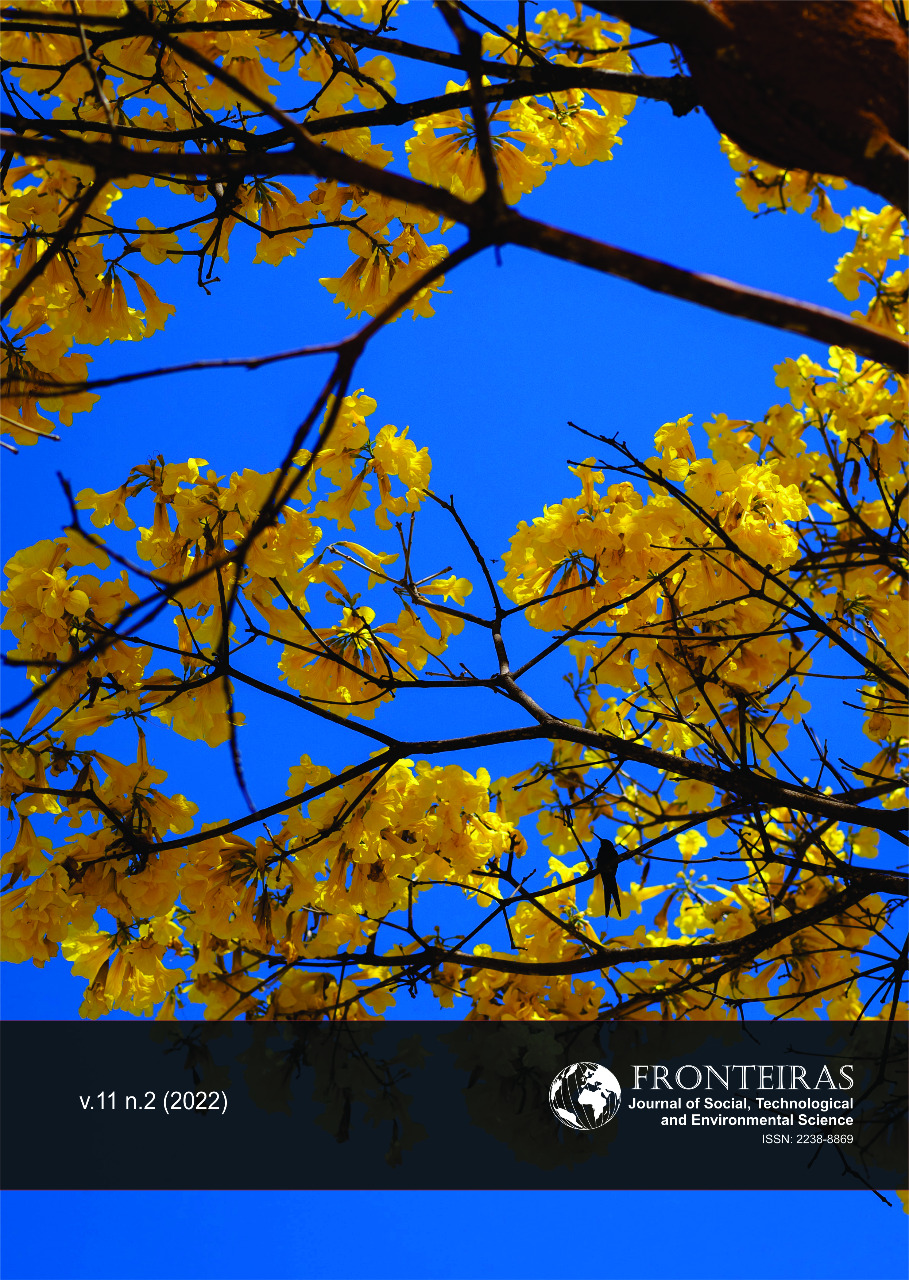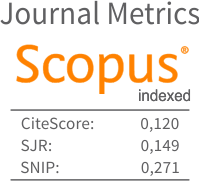Evaluation of Physicochemical and Microbiological Parameters of Wastewater Submitted to Constructed Wetland Treatment System
DOI:
https://doi.org/10.21664/2238-8869.2022v11i2.p131-140Palavras-chave:
filtros biológicos, tratamento de efluentes, águas residuais, wetlands construídos, esgotoResumo
O uso de sistemas naturais como wetlands construídos no tratamento de águas residuais, tem se tornado cada vez mais importante devido à capacidade desses sistemas em remover grandes quantidades de macronutrientes e micro-organismos, além de promover a degradação da matéria orgânica. Diante desse cenário, o objetivo principal deste trabalho foi avaliar a eficiência de um sistema experimental de fluxo horizontal de wetland construído em subsuperfície cultivado com Zantedeschia aethiopica preenchido com substratos de areia e cascalho. Os parâmetros foram avaliados por meio da caracterização de indicadores físico-químicos e microbiológicos do efluente da fossa séptica da Universidade Estadual de Goiás na cidade de Anápolis, Goiás, Brasil. A redução dos macronutrientes variou de 57,9 a 94,7% e de 87,0 a 91,0% para a matéria orgânica. Além disso, foram observadas reduções significativas de coliformes após o tratamento de águas residuais em áreas úmidas. Concluiu-se que o sistema wetland construído pode ser proposto para o tratamento de efluentes de fossas sépticas em nível secundário e terciário, devido ao seu alto percentual de eficiência na remoção de matéria orgânica e macronutrientes. Os resultados obtidos demonstraram a aplicabilidade do sistema estudado em ser utilizado como um tratamento versátil, sustentável e econômico de efluentes complementar ao sistema de tratamento de fossa séptica.
Referências
ABNT- Associação Brasileira de Normas Técnicas. Água - Determinação de potássio e sódio- Método da espectrometria de absorção atômica por chama: NBR 13811. Rio de Janeiro, 1997, 3.p.
ABNT- Associação Brasileira de Normas Técnicas. Água - Determinação de Cloreto- Métodos Argentométrico: NBR 5759 PMB1056. Rio de Janeiro, 1975, 5.p.
Ali S, Abbas Z, Rizwan M, Yavas I, Zaheer I, et al 2020. Application of floating aquatic plants in phytoremediation of heavy metals polluted water: a review. Sustainability, v. 12, n. 5, p. 1927.
Amaral BM, Alcântara DP, Ferreira EM, da Silva Cruvinel KA 2021. Efficiency of pollutant removal in a hybrid constructed wetland with Hedychium coronarium J. König: a sustainable alternative for poor communities. Monogr. Ambient, v. 20, p. 6.
Andrade HHB 2015. Avaliação de um Sistema de Tratamento de Águas Residuárias por Wetland Construído com Etapa Aerada. Programa de Pós-Graduação em Sustentabilidade, Universidade de São Paulo, EACH-USP, 10 pp.
APHA. In: Clesceri, L. S., A. E. Greenberg & A. D. Eaton (Eds.). Standard methods for the examination of water and wastewater, 20th edition. Washington, American Public Health Association, 1998, 48. p.
Berté VS, Gregori A, Thomé A 2005. Avaliação da eficiência da estação de tratamento de efluente da Universidade de Passo Fundo. Encontro Latino Americano de Universidades Sustentáveis – Universidade de Passo Fundo.
BRASIL. Resolução CONAMA Nº 430/2011 - "Dispõe sobre condições e padrões de lançamento de efluentes, complementa e altera a Resolução no 357, de 17 de março de 2005, do Conselho Nacional do Meio Ambiente - CONAMA."
Colares GS, Osbel ND, Wiesel PG, Oliveira GA, Lemos PHZ, et al 2020. Floating treatment wetlands: A review and bibliometric analysis. Science of the Total Environment, v. 714, p. 714.
Costa JF, de Paoli AO, Sperling MV, Seidl M 2018. Avaliação do desempenho de sistemas alagados construídos de escoamento horizontal subsuperficial tratando efluente de reator UASB, com base em quatro anos de monitoramento. Engenharia Sanitaria e Ambiental, v. 23, p. 191-200.
Dang MP, et al 2020. Study on Domestic Wastewater Treatment of the Horizontal Subsurface Flow Wetlands (HSSF-CWs) Using Brachiaria mutica. Waste and Biomass Valorization, v. 11, n. 10, p. 5627-5634.
Dell'Osbel N, et al 2020. Hybrid constructed wetlands for the treatment of urban wastewaters: increased nutrient removal and landscape potential. Ecological Engineering, v. 158, p. 106072.
Dornelas FL 2008. Avaliação do desempenho de wetlands horizontais subsuperficiais como pós-tratamento de efluentes de reatores uasb. 115 f. Dissertação de Mestrado em Saneamento de Meio Ambiente e Recursos Hídricos da Escola de Engenharia da Universidade de Minas Gerais, Belo Horizonte, 115 pp.
Dotro G, Langergraber G, Molle P, Nivala J, et al 2017. Treatments Wetlands – Biological Wastewater Treatment Series. IWA Publishing, v. 7, p. 11-12.
Gikas GD, Tsakmakis ID, Tsihrintzis VA 2017. Hybrid natural systems for treatment of olive mill wastewater. Journal of Chemical Technology and Biotechnology, v. 93, p, 800–809.
Greenway M 2004. Constructed Wetlands for Water Pollution Control - Processes, Parameters and Performance. Dev. Chemical Eng. Mineral Process, v.2, p. 491-504.
Ketema S, Ali M, Ilyas MA, Rehman FU, Tebeka M, et al 2021. Systematic review on constructed wetland for removal of nutrient from waste water. Asian Journal of Advances in Research, v. 8, p. 1-7.
Kumar S, Dutta V 2019. Constructed wetland microcosms as sustainable technology for domestic wastewater treatment: an overview. Environmental Science and Pollution Research, v. 26, n. 12, p. 11662-11673.
Matos AT 2012. Qualidade do meio físico ambiental: práticas de laboratório. Universidade Federal de Viçosa, MG: Ed. UFV, p. 4.
Nahiun KM, Sarker B, Keya KN, Mahir FI, Shahida S, Khan RA 2021. A Review on the Methods of Industrial Waste Water Treatment. Scientific Review, v. 7, n. 3, p. 20-31.
Parde D, Patwa A, Shukla A, Vijay R 2021. A review of constructed wetland on type, treatment and technology of wastewater. Environmental Technology & Innovation, v. 21, p. 101261.
Payne CE, Combs HF 1968. Determination of Magnesium in Vomitus by Atomic Absorption Spectrophotometry and EDTA Titration. Applied Spectroscopy, v. 22, p. 786–789.
Prata RCC, Matos AT, Cecon PR, Monaco PAV, et al 2013. Tratamento de esgoto sanitário em sistemas alagados construídos cultivados com lírio-amarelo. Engenharia Agrícola, Jaboticaba, v. 33, p. 1144-1155.
Rana V, Maiti SK 2020. Municipal and industrial wastewater treatment using constructed wetlands. Phytoremediation, v. 10, p. 329-367.
Raouf MEA, Maysour NE, Farag RK, Raheim A, Raheim MA 2019. Wastewater treatment methodologies: review article. International Journal of Enviroment & Agricultural Science, v. 3, p. 018.
Rousso BZ, Pelissari C, dos Santos MO, Sezerino PH 2019. Hybrid constructed wetlands system with intermittent feeding applied for urban wastewater treatment in South Brazil. Journal of Water, Sanitation and Hygiene for Development, v. 9, p. 559-570.
Santos BSD, et al 2016. Avaliação da Eficiência de Um Sistema de Tratamento por Wetland Construído Aplicado ao Efluente de um Frigorífico de Suínos. Semina: Ciências Exatas e Tecnológica, v. 37, p.13.
Sarma J 2020. Filtration and chemical treatment of waterborne pathogens. In: Waterborne Pathogens. Butterworth-Heinemann, v. 6, p. 105-122.
Schierano MC, Panigatti MC, Maine MA, Griffa CA, Boglione R 2020. Horizontal subsurface flow constructed wetland for tertiary treatment of dairy wastewater: Removal efficiencies and plant uptake. Journal of Environmental Management, v. 272.
Shindhal T, Rakholiya P, Varjani S, Pandey A, Ngo HH, et al 2021. A critical review on advances in the practices and perspectives for the treatment of dye industry wastewater. Bioengineered, v. 12, n. 1, p. 70-87.
Sperling MV 2003. Introdução a Qualidade das Águas e ao Tratamento de Esgotos. Vol. I, Desa, Minas Gerais, 239 pp.
Torrens A, Folch M, Salgot M 2021. Design and Performance of an Innovative Hybrid Constructed Wetland for Sustainable Pig Slurry Treatment in Small Farms. Frontiers in Environmental Science, v. 8, p. 1-13.
Travaini LF, Sipaúba TLH 2012. Efficiency of a constructed wetland for wastewater treatment. Acta Limnologica Brasiliensia, v. 24, n. 3, p. 255-265.
Vohla C, Koiv M, Bavor HJ, Chazarenc F, Mander U 2011. Filter materials for phosphorus removal from wastewater in treatment wetlands - A review. Ecological Engineering, v. 37, p. 70–89.
Yang Y, Zhao Y, Liu R, Morgan D 2018. Global development of various emerged substrates utilized in constructed wetlands. Bioresource Technology, v. 261, p. 441-452.
Yaqoob AA, Parveen T, Umar K, Ibrahim MNM 2020. Role of nanomaterials in the treatment of wastewater: a review. Water, v. 12, n. 2, p. 495.
Zanella L 2008. Plantas ornamentais no pós-tratamento de efluentes sanitários, Campinas. Dissertação de Doutorado em Engenharia Civil, Faculdade de Engenharia Civil, Arquitetura e Urbanismo de São Paulo, 219 pp.
Downloads
Publicado
Como Citar
Edição
Seção
Licença
Esta revista oferece acesso livre imediato ao seu conteúdo, seguindo o princípio de que disponibilizar gratuitamente o conhecimento científico ao público proporciona maior democratização mundial do conhecimento.
A partir da publicação realizada na revista os autores possuem copyright e direitos de publicação de seus artigos sem restrições.
A Revista Fronteiras: Journal of Social, Technological and Environmental Science segue os preceitos legais da licença Creative Commons - Atribuição-NãoComercial 4.0 Internacional.


